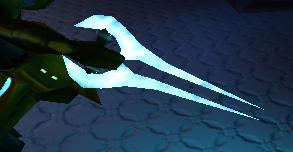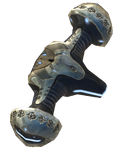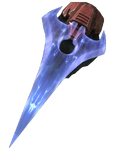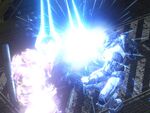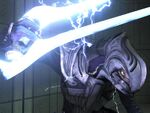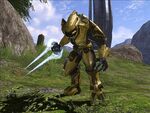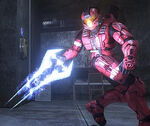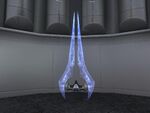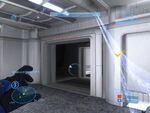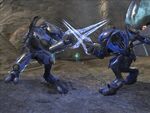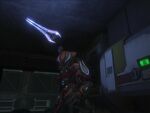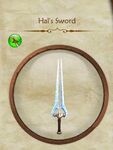| This article may not meet Halo Alpha's standards. You can help by cleaning this article. |
- “A noble and ancient weapon, wielded by the strongest of Sangheili, requires great skill and bravery to use, and inspires fear in those who face its elegant plasma blade.”
The Type-1 Energy Weapon/Sword, commonly known as the Energy Sword, is a close-quarters weapon of the Covenant Empire, for exclusive use of the Sangheili.[4]
Use[]
The Energy Sword is the signature weapon of the Sangheili, and has been their weapon of nobility since its creation during one of their Ages of Discovery.[5] Viewed as a holy weapon,[6] the Sangheili pride themselves on their skills with it.[7] They believe that it is better for a Sangheili to fall on his sword as an act to redeem his honor.[6][8][9] The Sangheili are also very strict on who can be trained in the art of swordsmanship - only aristocrats are permitted to wield Energy Swords, and sword wielders are no longer eligible for marriage. Breeding with any female they choose is permitted, married or otherwise, to ensure successful transmission of "swordsman" genes.[10] In service to the Covenant, Sangheili of a high or important rank are permitted to wield this weapon - lower ranks are not permitted to wield the sword because of its high status.[6] In the Covenant, Sangheili Ultras, Sangheili Zealots, Special Operations Sangheili, Stealth Sangheili, Sangheili High Councilors, and Sangheili Honor Guardsman are permitted to use Energy Swords.
Design[]

A blueprint of the energy sword in Halo 2.

A blueprint of the energy sword in Halo: Reach.
The Type-1 Energy Weapon/Sword consists of a curved hilt, housing an energy storage module and a device for projecting the plasma which forms the blade. The actual blade is composed of two partially ionized 'blades' of free moving electron based gas held in a blade-like form by two small magnetic-field generators built into the handle of the weapon. This forms and contains the oval shaped, ionized blades for which the weapon is recognized.[4][11] The battery's energy is reduced for each successful strike. Each killing strike from the sword will drain the battery by 10% of its energy. Once the battery power is fully depleted, the sword will deactivate unless recharged, something players couldn't do until Halo Infinite.
The hilt of the sword (Halo 3) displays multiple Forerunner symbols. The Halo 2 version has multiple symbols that yet are unknown to be Forerunner.
The Type-1 Energy Weapon contains a failsafe mechanism witnessed during the Battle of Installation 04 that can permanently disable the weapon if the Sangheili wielding it drops it.[12] When dropped, the failsafe engages by deactivating the magnetic field before dispersing the energy. The energy then consumes the handle and thus destroys the weapon.[13] The failsafe is included to prevent enemy infantry from acquiring the weapon and using it, and is yet another insight to Sangheili tactics. The failsafe seems to be rarely used, or was only included in a variant of Energy Sword issued to the Covenant ground forces deployed to Installation 04 by the Fleet of Particular Justice.
Advantages[]
The Type-1 Energy Weapon is an extremely powerful and devastating melee weapon when applied during close quarters combat. A single slash can penetrate through the energy shield systems and into the armor and flesh of a Spartan or a Sangheili. This is due to the design of the weapon's blade, which utilizes magnetically sealed, partially ionized, free moving electron based gas rather than traditional shaped, solid matter. The Type-1 Energy Weapon's edge is therefore considered exceedingly unstable and volatile, being able to slice through even the toughest metals with ridiculous ease, including ODST battle armour and the Titanium-A class plating of UNSC destroyers.[14][15]
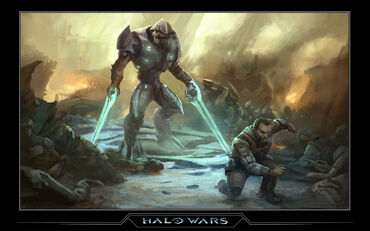
A Sangheili dual-wielding Energy Swords
Injuries to living creatures by the Type-1 Energy Weapon can range from bad to gruesome. Stab wounds by the Type-1 Energy Weapon are in most cases fatal — as the blade passes through the body, the innards of the body are burned and cauterized by the extreme temperatures produced by the blades.[16] Survival is minimal at best, and in the case of non-vital organs being stabbed with the energy sword, proper medical treatment must be applied as soon as possible, to ensure long term survival. Because of the sword's sheer destructive power, common forms of fatality to victims include impalement,[17][18][14] loss of limbs,[19] bodies being bisected,[14][20] and decapitation.[21][22]
The sheer destructive power of the sword makes it a weapon to be feared on any battlefield, and it is notable for its adverse psychological effects on human soldiers.[11]
Disadvantages[]
The Type-1 Energy Weapon's most glaring downside is that it is purely a close-quarters weapon; any combat engagement outside the effective range puts the wielder at risk of long-range retribution. It is for this reason that the Sangheili approach sword combat on the battlefield in two distinct ways, by funnelling the enemy into close-quarters to allow them to strike, and/ or to apply a form of stealth using both technology and technique. Without these, the user is vulnerable to attack by all forms of ranged attack, especially from sniper-based counterstrikes. Infantry with Overshields are also more resistant when facing this weapon as it can take two strikes before the shield system fails, and then another for the killing blow.
Furthermore, the Type-1 Energy Weapon is vulnerable to other magnetic fields, as they can block, disrupt, or possibly even alter the functionality of the sword. Two energy blades clashing together create a small disruption of energy as a result of the same type of magnetic fields clashing together; this clash has a slight area of effect damage that can affect the combatants.
As with most other Covenant weapons, the Type-1 Energy Weapon is battery powered, requiring the user to either recharge the weapon (which can never be performed in-game) or discard it when the power is depleted. Although the handle can generally be used as a club, the Energy Sword's combat effectiveness at that point is minimal, and in fact, negligible. The strength and lethality of the sword in the games are compensated for the sake of gameplay.
Last but not least, the Type-1 Energy Weapon can sometimes betray the position of a Sangheili warrior employing active camouflage due to the weapon's energy output.
Changes[]
Changes from Halo: Combat Evolved to Halo 2[]
In Halo: Combat Evolved, the Energy Sword has a cyan glow, a far less defined edge and makes a dull clunk when striking an object. It is only used by Stealth Sangheili and Zealots. The player cannot wield the energy sword due to the failsafe mechanism device that destroys the weapon upon killing the sword-wielder. It maintains this appearance, albeit with slightly more detail in Anniversary.
In Halo 2, the energy sword is blue with purple undertones and electrical energy crackling on it when the blade is activated. The white glow seen in Halo: Combat Evolved is also replaced with a more glass like transparency. In the campaign, it is only used by higher-ranking Sangheili, such as special operations units, Ultras and Zealots, though players can now wield the sword. The sword in campaign has a battery and can only be used effectively against a limited number of enemy forces before the battery runs out. The sword is usable in multiplayer with an infinite battery power. The Energy Sword has two modes of attacking; a lunge attack and a swing attack.
In Halo 2: Anniversary from The Master Chief Collection, the Energy Sword is was redesigned slightly to resemble the iteration from Halo: Reach more.
Changes from Halo 2 to Halo 3[]
In Halo 3, the sword has more of a light cyan tinge, similar to its appearance in Halo: Combat Evolved, but still has a tint of purple near the handle. It also has an angle near the handle, whereas in the two previous games it was curved. Players are now able to parry with the sword. The power exerted by the swords hitting each other will drain both players' shields, but will not kill them unless one makes the fatal blow. The sword's lunge attack has been reduced for balancing purposes, aside from these changes in design and functionality, the power of the sword remains unchanged. In multiplayer, the sword has a limited battery supply.
Changes from Halo 3 to Halo: Reach[]
In Halo: Reach, the sword has less space between the blades. The sword resembles closely to the design used in Halo: Combat Evolved, albeit darker in color and further apart above the hilt. When activated, the sword is capable of lighting up the surrounding area. When unused, the sword rests differently on the Spartan and Sangheili character models. The energy sword appears to have been balanced out compared to its earlier incarnations, having a slightly faster swing than its Halo 3 incarnation. Its lunge attack has been reduced in range and can now be blocked by a well-timed melee.[23] The energy sword has its own assassination animations, which are used in place of the Spartan combat knife and the Sangheili energy blade.[24] Sangheili also hold the sword farther back than Spartans do and actually hunch down slightly when they switch to the sword. The sword can now also be lowered using the Alert carry trick. The Energy Sword now has a "swing time" of about 1.5 seconds in which an object or player in front of the sword can take damage, allowing the player to kill enemies by swinging then moving into an enemy, rather than a lunge, where a player will move to an enemy before striking. Finally, it appears that the Energy Sword always does the same damage, regardless of whether the hit is a melee or a lunge.
Changes from Halo: Reach to Halo 4[]
Similar to Halo: Reach, the Halo 4 energy sword also has less space between the two blades and the points of each blade also don't extend as far pass the hilt's sword emitters. The activation sound has changed and is now higher in pitch. The aiming reticle has also changed and is now a more complete circle than in past games. You can also drain the sword's energy by hitting a solid surface rather than just an enemy.
Changes from Halo 4 to Halo 5: Guardians[]
In Halo 5: Guardians, the weapon itself appears "sharper," and the sound effects are more metallic. When wielding the energy sword the player moves slightly faster, Spartan Charges are an instant-kill, and Smart Scoping allows for more range and lunge distance. Several REQ variants are also featured in the game, each with its own abilities and appearance including faster swinging, extra thrust charges, or Active Camouflage. The energy sword no longer drains energy when hitting surfaces, only by striking specific destructible objects and enemies.
Changes from Halo 5: Guardians to Halo Infinite[]
The blade has returned to how it appears in Halo: Reach. Overall, its appearance has been made more ethereal, with edges that form a soft gradient into transparency, and a gentle, fire-like aura eminating upwards at all times. The sound effects resemble that of an electric surge, with a sharp hissing sound on successful attacks. While the weapon can insta-kill larger enemies from behind, care should be taken when engaging head-on. The lunge range has seemingly been reduced by a small margin. Movement speed seems largely unaffected when weilding the sword. Additionally, the blade is now rechargeable, and will automatically refill when the player passes over other discarded blades in the environment. Power Ammo stations also exist where the player can refill any Power-type weapon's ammo capacity.
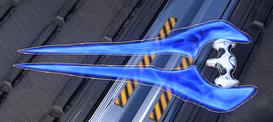
Duelist variant
Duelist Energy Sword[]
In addition to the standard Energy Sword, a unique Duelist variant can be unlocked by assassinating high-value target, Okro 'Vagaduun. The Duelist Sword appears mostly the same. However, the hilt is painted white in some areas, and the blade itself is a deeper blue. The Duelist grants faster attack and movement speed over the standard Energy Sword, as well as a noticeably increased lunge distance (Comparable to the Commando Pro boost from Call of Duty), potentially as a callback to the humorously long lunge range from Halo 2. It appears in the multiplayer as one of the variants available in Fiesta. Similarly to other Banished variant weapons, the Duelist is considered distinct from its common counterpart. Both can be weilded in separate weapon slots, the Energy Sword can't refill on discarded Duelists, and vice-versa.
Elite's Bloodblade[]
A third variation of the Energy Sword, the Bloodblade is obtained by defeating Jega 'Rdomnai during the final campaign mission. It is distinguished from both of its counterparts in that it features a vivid scarlet colouration, alongside higher damage and a hardlight disintegration effect upon killing an enemy. However, it doesnt have the increased movement speed and jump height of the Duelist.
In other media[]
In Halo Graphic Novel's The Last Voyage of the Infinite Succor, there is a variety of sword-type weapons hung on a wall in the dueling chamber of the Seeker of Truth.[25] These range from energy clubs to sickle-like plasma weapons. The sword used by Rtas 'Vadum and Bero 'Kusovai in their duel changed its design a number of times to exhibit the basic structure of the Type-1 with a few slight differences. In the story Second Sunrise Over New Mombasa, a Sangheili is shown with a very odd, light-pink sword with very thin blades.[26]
During the events of Halo Wars, the Arbiter, Ripa 'Moramee, sported two energy swords with modified hilts and hand-guards. In the Halo: Evolutions - Essential Tales of the Halo Universe Headhunters short story, a new energy sword variant is introduced; it is described as being composed of a red-hued energy combined with a white electrical flicker, giving it a blood-colored glow.
Tactics[]
There are two ways a player in Halo 2, Halo 3, Halo: Reach and Halo 4 can attack. The first is to lunge with the energy sword. With this, the player lunges forward at the other player. However, this only works when the aiming reticle is lit red, indicating that the opposing player is within range. The second attack is the simple melee, which is a quick underhanded or overhanded swipe.
Campaign[]
- In Halo 2, the sword is extremely valuable against Sangheili in campaign. When facing sword-wielding Sangheili a sound tactic is to jump and lunge attack them. This will kill them quickly and save your shields or your life on higher difficulties.
- In both Halo 2 and Halo 3, the Energy Sword is a very strong anti-Flood weapon, as it will destroy Flood Combat Forms and Flood Pure Forms in one strike (although if an infected Sangheili still has its shield, it may take two or more swipes, depending on the difficulty setting). Due to its limited energy supply it's more advisable to use a Brute Shot to melee instead, as it serves the same function and cannot run out of energy.
- When fighting against the Flood, an attack with the Energy Sword will deplete the battery by a very small amount (about 2.5%) due to their soft tissue, making it useful for extended durations.
- The Energy Sword in Halo 2 and Halo 3 can be used to destroy the corpses of Flood Combat Forms so that they cannot be re-infected by Flood Infection Form. However, the cutting process does drain battery power. Although, any weapon's melee attack can be used to destroy combat form corpses if used enough times, even a depleted Energy Sword hilt.
- In Halo 3, the Energy Sword is very hard to come by in the campaign outside of Floodgate, Cortana, and Halo. The player can obtain an Energy Sword by killing a Sangheili ally on The Covenant or by draining Arbiter's shield during combat (this happens more frequently on higher difficulties). If you do, it is a very good weapon against the Jiralhanae, although the battery will deplete very quickly.
- In Halo: Reach, the energy sword is a valuable weapon in campaign, ironically best used against its former owner. The sword is especially useful on the level Long Night of Solace, since it provides a quick kill against the various Sangheili stationed on the Corvette. It is able to kill all lower Covenant species and Sangheili Minors, Sangheili Rangers and Special Operations Sangheili with one strike, and it only takes two strikes to kill Sangheili Ultras and all Sangheili Zealots.
- When combating againist an enemy using an energy sword, it is essential to keep your distance from them. Try using your ranged weapons aganist an enemy wielding an energy sword.
Multiplayer[]
- The sword is easily one of the best close range weapons to use in Halo 2. The best tactic is to lay into an enemy player with your secondary weapon getting closer, then when within range perform a quick swipe with the sword for the finishing move. However, since there is no way of telling which player has the sword, or no sound way to stop it, it has often been labeled as a cheap tactic.
- Using Active camouflage with the sword in Halo 2 is not a wise thing to do as the sword in Halo 2 is still visible with it active. In Halo 3 however, using the sword with active camouflage is a sound tactic as it will now cover the sword when picked up.
- In Halo 3, if a Mongoose is coming at you, you can actually sword-lunge over the windshield and kill the driver or passenger if there is one. But it requires very precise timing.
- In Halo 3, the sword lunge is shorter, and the player cannot perform a quick strike. In addition, the sword's handle is now visible on the character's leg. In order for the sword to be most effective the player must lure a player into a trap where the sword will become effective; camping with the sword in a corner and waiting is the best way to use it to its fullest extent. As a special note, there is a range difference between the B button melee, and the right trigger lunge. The lunge has the maximum range, whilst the B button seems to only work at 1/2 to 3/4 the range. This is most likely for balancing, as the B button swings the sword at a much faster rate.
- If the enemy controls the sword room in the Halo 3 multiplayer map The Pit, stick to the outer wall. The range is just short of the wall and if you're lucky your opponent will lunge and miss, giving you the perfect opportunity to kill him or her.
- Occupants in vehicles can be killed with a sword with precise timing. This is extremely difficult to do and is not recommended in plain view.
- It is possible to dodge a lunge from the Energy Sword. To do this, one must move quickly to the right when facing the lunging opponent, towards the hand which does not hold the sword. Conversely, to prevent your target from dodging your lunge, simply jump; jumping reduces all chances of missing or being dodged by an opponent.
- In Halo 3, a new feature has been added so that players can parry their opponent's sword by meleeing or lunging at the same time. If you pull the right trigger right before the other person makes contact, a parrying electric clash is produced, but you do lose some or all of your shield. However, when you get down to no shields, a sword clash will not affect your health, though your screen will flash bright red. This is sometimes known as "Fencing," and can be a game, first to die loses, a useful tactic to use in sword-on-sword fight is, once you parry, melee with the sword. If you time it well enough the sword fight can last indefinitely.
- Jumping can make the Energy Sword much more fearsome, brutally effective and accurate. Jump and point your reticle down, waiting until it turns red to lunge at the opponent.
- In Halo 2 avoiding a sword lunge is extremely difficult, if timed correctly and with a bit of luck, side stepping in the direction of the enemy players free hand may save your life, however this is often difficult. In Halo 3, avoiding a sword lunge can be done by using either a Brute Shot or a Shotgun, there is still some difficulty in pulling it off, but the odds of killing an enemy player using the Sword is much greater than on Halo 2.
- An extremely useful tactic against another player wielding an Energy Sword is to, rather than hitting B twice for two quick melees, strike first with a melee, and then finish them on with the lunge. This tactic is much quicker with two melees, to compensate for the blowback from the initial parry.
- In Halo: Reach, a player may block a sword lunge with any weapon they are carrying at the time, although they will lose drastic amounts of health and shielding. This is done by simply meleeing the incoming attack and stopping the attack with a well timed strike. Fast ambushes must be made to prevent enemy players from parrying your lunge.
- The Energy Sword is efficient when used in combination with the Sprint or Evade armor ability, and deadly with Active camouflage.
- In Halo 5: Guardians, a player can increase the range of their lunge by using their smart scope. However, they will not be able to see their radar.
Trivia[]
- The Fable 2: Limited Edition comes with "Hal's Sword," a crystal blade shaped like an Energy Sword for in-game use, to coincide with the use of "Hal's Armour," which resembles Mjolnir armor.[27]
- In Halo 2 and Halo 3, a glitch can be performed to give the player a Silhouette Sword.
- In Halo 3 and Halo: Reach, seven Forerunner glyphs are visible on each side of the Energy Sword's hilt.
- In Halo Wars, the Energy Sword is called a Plasma Sword.
- In Halo: Reach, if an Energy Sword is put in the water, the blade becomes invisible. If the sword is placed pointing upward, the parts of the blade near the hilt are not visible, but the tips are.
- Xbox marketplace offers an Energy Sword Prop for Xbox Avatars.[28]
- Swords kingdom provides an Energy Sword prop replica to its reliable customers.
- In Halo 2: Anniversary, there is an Red Infected Energy Sword made for the Anniversary's Infection gametype.
- Destiny 2 Includes the Energy Sword as 2 Weapons, One Arc (Half-Truths) And one Void (The Other Half) Aswell as A Finisher Called "Birthday Blade" As part of Bungie's 30th anniversary Event. Interestingly, each variant only has part of the blade, and a description notes that they look like there is something is missing.
Gallery[]
Concept Art[]
Render[]
Overview[]
Misc.[]
Appearances[]
Sources[]
- ↑ Halo: The Essential Visual Guide, page 63
- ↑ Halo Encyclopedia, page 334
- ↑ Halo 2: Special Collector's Edition Manual
- ↑ 4.0 4.1 Bungie.net: Halo Reach Ordnance Guide: T1 EW/S
- ↑ The Covenant Hall of Murals
- ↑ 6.0 6.1 6.2 Halo Encyclopedia page 127
- ↑ Halo Graphic Novel page 12 - 14
- ↑ Halo: The Cole Protocol page 53
- ↑ Halo: The Cole Protocol page 141
- ↑ Bestiarum Sangheili section
- ↑ 11.0 11.1 Halo Encyclopedia page 335
- ↑ Halo: First Strike page 74
- ↑ Halo: Combat Evolved
- ↑ 14.0 14.1 14.2 Halo: The Cole Protocol page 76 Cite error: Invalid
<ref>tag; name "cole" defined multiple times with different content - ↑ Halo: First Strike page 72
- ↑ Halo: Evolutions - Essential Tales of the Halo Universe Midnight in the Heart of Midlothian page 91
- ↑ Halo 4: Forward Unto Dawn
- ↑ Halo Wars
- ↑ Halo: The Cole Protocol page 76
- ↑ Halo: Ghosts of Onyx page 360
- ↑ Halo: Evolutions - Essential Tales of the Halo Universe Midnight in the Heart of Midlothian page 101
- ↑ Halo: The Cole Protocol page 80
- ↑ Bungie.net: Halo: Reach Beta Survival Guide
- ↑ Youtube - SDCC: Halo Reach Panel Part 2: 1:15 into video -- "So we do have unique assassinations for the sword now... - Lars Bakken"
- ↑ Halo Graphic Novel, The Last Voyage of the Infinite Succor page 14
- ↑ Halo Graphic Novel, Second Sunrise Over New Mombasa page 95
- ↑ Joystiq: Fable 2's Spartan armor and Energy Sword pictured
- ↑ Xbox Markerplace
See also[]
- Energy Dagger
- Type-2 Energy Weapon/Hammer
- Unlimited Energy Sword
| |||||||||||

